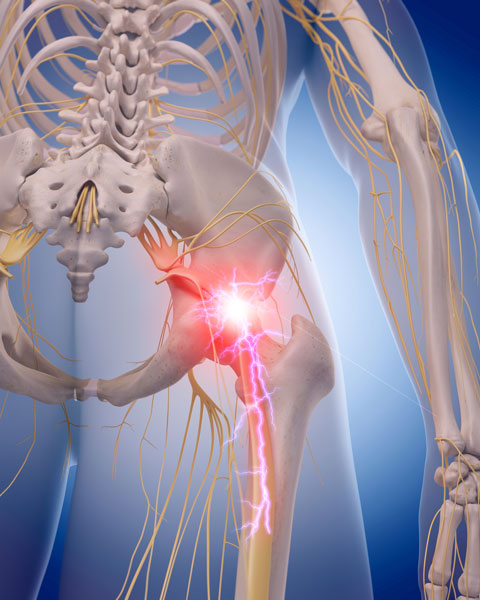
The leading cause of job-related injury in the United States is due to back pain. In fact, 80% of adults will suffer from lower back pain in their lifetime. A common and very painful type of back pain is called sciatic nerve pain. Finding the cause of this pain and having a proper exam can lead to a quicker and longer lasting recovery from this painful condition.
What is Sciatica?
Irritation of the sciatic nerve can cause many painful problems. The sciatic nerve is the largest nerve in the body. It is formed by the nerve roots coming out of the spinal cord into the lower back. The sciatic nerve runs down through the buttock, then the nerve branches down the back of the leg leading to the ankle and foot. Once irritated, this nerve can causes tingling, burning lower back pain that can travel all the way down the leg and even cause numbness. Pain may be felt anywhere along the nerve’s pathway.
Causes of irritation
In most cases, a bulging or herniated disc is the culprit of sciatic nerve pain. The bulging disc is often pressing on the nerve roots that lead to the sciatic nerve. Other causes of sciatica may include spinal stenosis, bone spurs, a pinched nerve, arthritis, injury or other other changes in the spine. In some cases, sciatica can be caused by pregnancy or tumors.
Symptoms
A burning sensation of pain that is felt in the lower back or buttock that moves down into the leg might be caused by sciatica. Weakness, tingling or numbness in the leg have also been reported. Pain increases when standing or sitting for long periods of time or when the spine is flexed (bringing the knee to the chest). If pain eases up when walking, lying down or extending the spine, sciatica could be the reason for the pain.
Diagnosis
A diagnosis of sciatic nerve pain is done by a physical exam and proper history of pain by a medical doctor. After a complete review, an x-ray or MRI (magnetic resonance imaging) might be used to further investigate the cause of pain.
Risk Factors
There are situations where the incidence of sciatic nerve pain does increas. Age does play a huge factor in developing sciatic nerve pain. Herniated discs and bone spurs that cause sciatica are usually due to age related changes in the spine. Obesity can also cause changes in the spine and unwanted pressure. A sedentary lifestyle can also increase the risk of sciatica compared with people who are more active. Lastly, diabetics are at an increased risk of developing sciatic nerve pain.
Treatment
When it comes to sciatic nerve pain, patience is key. Initially, treatment tends to focus on medication to reduce pain and doing proper exercises, while resting.
Other ways to help alleviate pain may include avoiding sitting in positions that put pressure on the nerve. It may also be helpful to alternate between lying down and taking short walks. Over-the-counter pain reducers like acetaminophen, ibuprofen and naproxen might also take the edge off. Lastly, applying heat or a cold pack to the affected area could be helpful depending on the situation.
In advanced situations, a doctor may suggest other treatment options. Physical therapy is always an option when the pain progresses or cannot be relieved. When it comes to chronic forms of sciatica, transcutaneous nerve stimulators (TENS units) might help alleviate the pain. Injections of steroids and stronger pain medications like opiates may also be prescribed. In severe cases, surgery may even be an option.
As with many types of back pain, often a bit of patience, time, and rest will help alleviate the pain. However, if any of the following more severe symptoms happen, contacting a doctor immediately is vital:
- Difficulty controlling your bladder
- Difficulty controlling your bowels
- Muscle weakness
- Severe pain following a violent injury

How long does sciatica pain last?
For some, sciatica pain can be short term or temporary. The pain may only last days to weeks if caused by disc herniation, back sprain, shingles or degenerative lumbar spine. However, these can also lead to chronic sciatic nerve pain.
What is the prognosis (outlook) of sciatic nerve pain?
The prognosis or outlook of healing from sciatic nerve pain depends on the precise cause of pain and duration of symptoms. Recovery from sciatic nerve pain ranges from excellent to having long-term chronic symptoms. When the pain is acute, often people are back to work within a month and fully recovered up to 7 weeks later.
Comments are closed.
